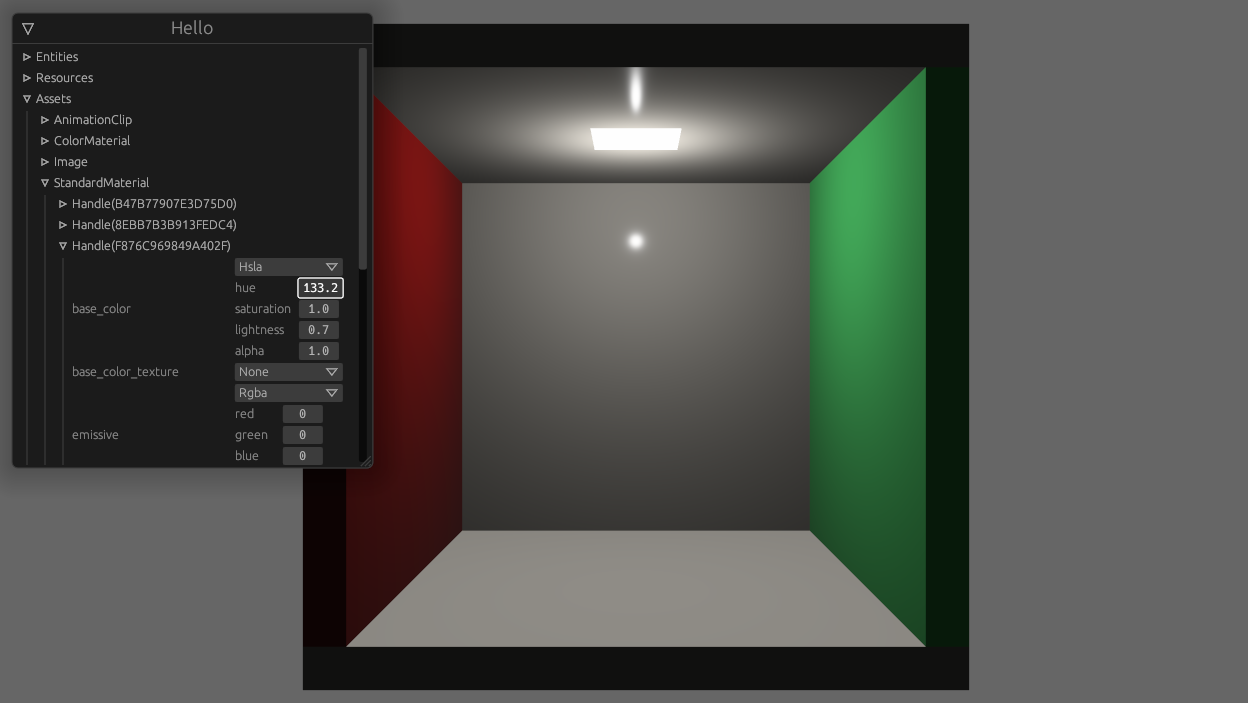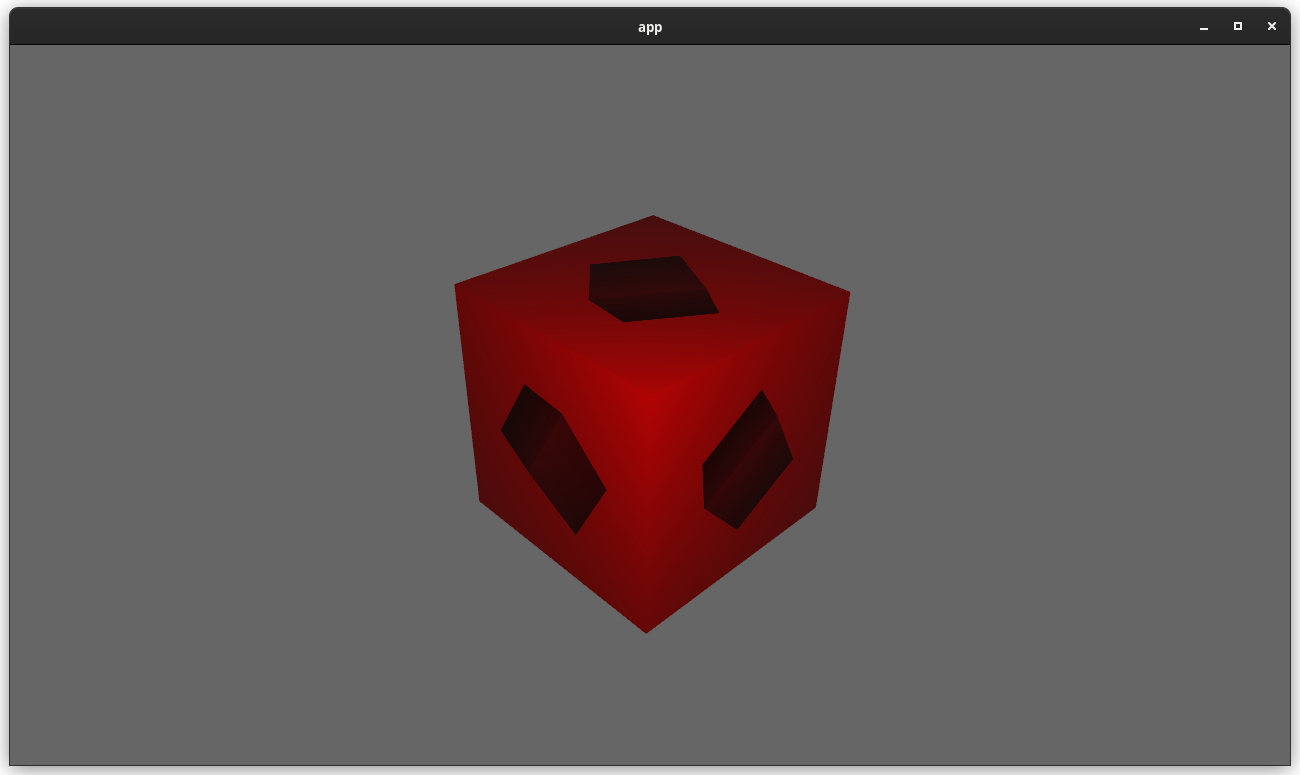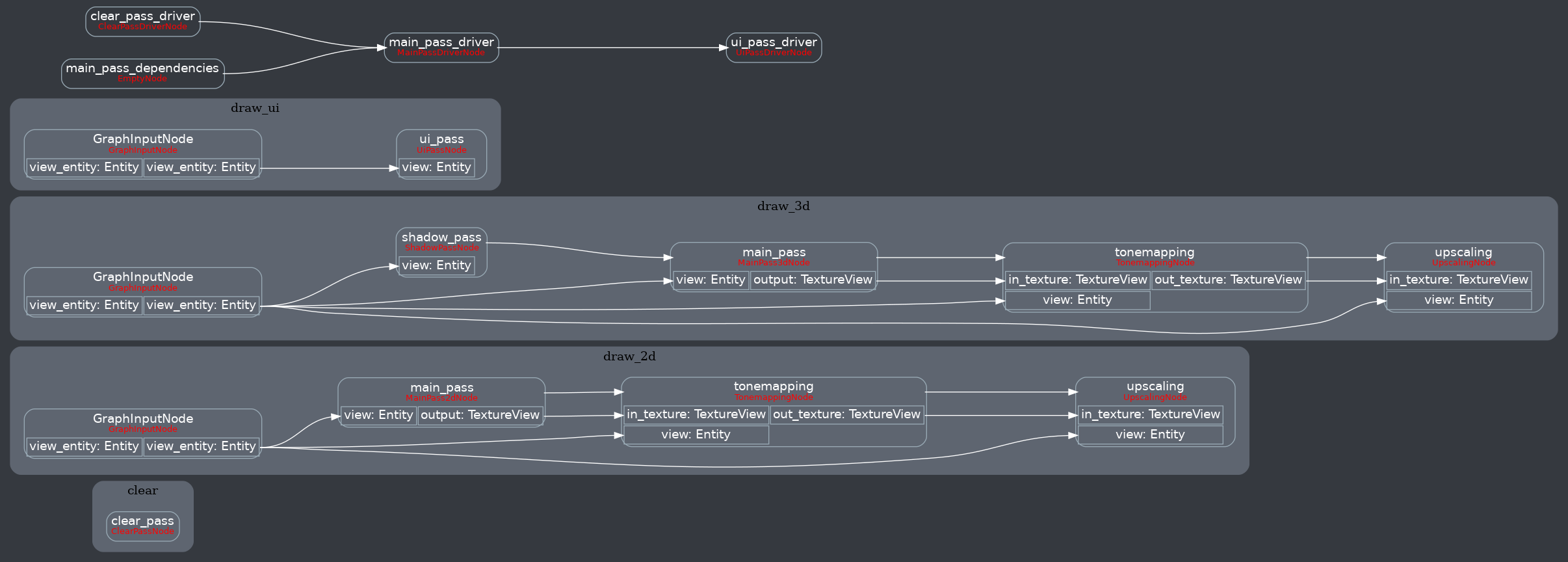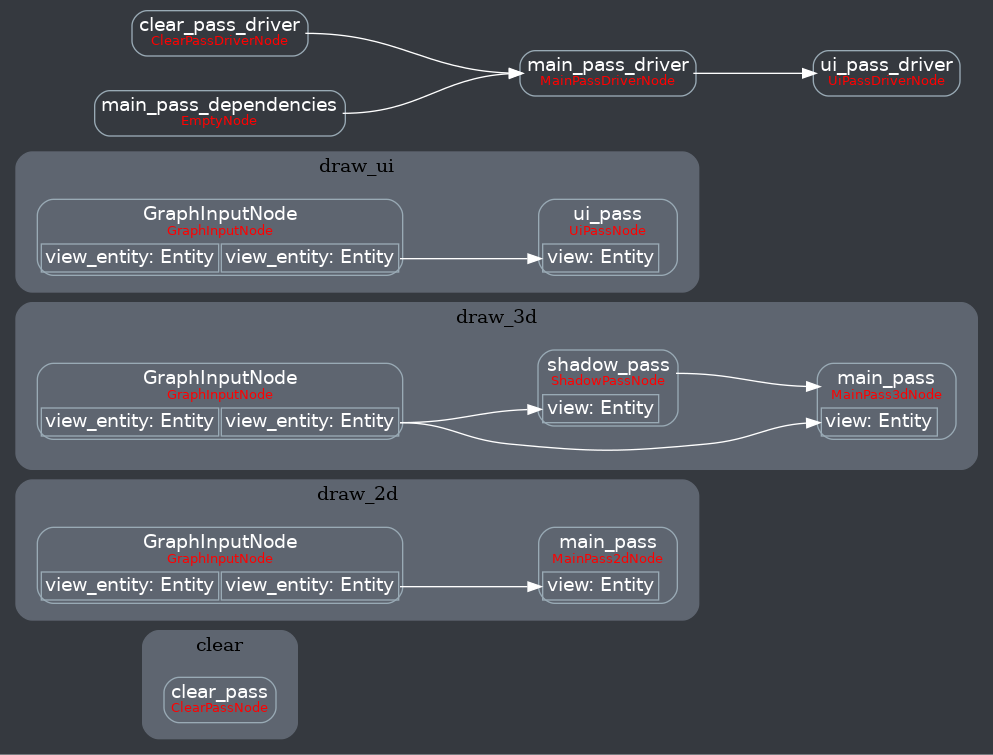# Objective
- Fixes#6841
- In some case, the number of maximum storage buffers is `u32::MAX` which doesn't fit in a `i32`
## Solution
- Add an option to have a `u32` in a `ShaderDefVal`
# Objective
`prepare_asset` for Image has an alternate path for texture creation that is used when the image is not compressed and does not contain mipmaps. This additional code path is unnecessary as `render_device.create_texture_with_data()` will handle both cases correctly.
## Solution
Use `render_device.create_texture_with_data()` in all cases.
Tested successfully with the following examples:
- load_gltf
- render_to_texture
- texture
- 3d_shapes
- sprite
- sprite_sheet
- array_texture
- shader_material_screenspace_texture
- skybox (though this already would use the `create_texture_with_data()` branch anyway)
# Objective
The soundness of the ECS `World` partially relies on the correctness of the state of `Entities` stored within it. We're currently allowing users to (unsafely) mutate it, as well as readily construct it without using a `World`. While this is not strictly unsound so long as users (including `bevy_render`) safely use the APIs, it's a fairly easy path to unsoundness without much of a guard rail.
Addresses #3362 for `bevy_ecs::entity`. Incorporates the changes from #3985.
## Solution
Remove `Entities`'s `Default` implementation and force access to the type to only be through a properly constructed `World`.
Additional cleanup for other parts of `bevy_ecs::entity`:
- `Entity::index` and `Entity::generation` are no longer `pub(crate)`, opting to force the rest of bevy_ecs to use the public interface to access these values.
- `EntityMeta` is no longer `pub` and also not `pub(crate)` to attempt to cut down on updating `generation` without going through an `Entities` API. It's currently inaccessible except via the `pub(crate)` Vec on `Entities`, there was no way for an outside user to use it.
- Added `Entities::set`, an unsafe `pub(crate)` API for setting the location of an Entity (parallel to `Entities::get`) that replaces the internal case where we need to set the location of an entity when it's been spawned, moved, or despawned.
- `Entities::alloc_at_without_replacement` is only used in `World::get_or_spawn` within the first party crates, and I cannot find a public use of this API in any ecosystem crate that I've checked (via GitHub search).
- Attempted to document the few remaining undocumented public APIs in the module.
---
## Changelog
Removed: `Entities`'s `Default` implementation.
Removed: `EntityMeta`
Removed: `Entities::alloc_at_without_replacement` and `AllocAtWithoutReplacement`.
Co-authored-by: james7132 <contact@jamessliu.com>
Co-authored-by: James Liu <contact@jamessliu.com>
# Objective
- Since #5900 3d examples fail in wasm
```
ERROR crates/bevy_render/src/render_resource/pipeline_cache.rs:660 failed to process shader: Unknown shader def: 'AVAILABLE_STORAGE_BUFFER_BINDINGS'
```
## Solution
- Fix it by always adding the shaderdef `AVAILABLE_STORAGE_BUFFER_BINDINGS` with the actual value, instead of 3 when 3 or more were available
# Objective
- Support textures in `Rgb9e5Ufloat` format.
## Solution
- Add `TextureFormatPixelInfo` for `Rgb9e5Ufloat`.
Tested this with a `Rgb9e5Ufloat` encoded KTX2 texture.
# Objective
- Every usage of `DrawFunctionsInternals::get_id()` was followed by a `.unwrap()`. which just adds boilerplate.
## Solution
- Introduce a fallible version of `DrawFunctionsInternals::get_id()` and use it where possible.
- I also took the opportunity to improve the error message a little in the case where it fails.
---
## Changelog
- Added `DrawFunctionsInternals::id()`
# Objective
- Reduce confusion around uniform bindings in materials. I've seen multiple people on discord get confused by it because it uses a struct that is named the same in the rust code and the wgsl code, but doesn't contain the same data. Also, the only reason this works is mostly by chance because the memory happens to align correctly.
## Solution
- Remove the confusing parts of the doc
## Notes
It's not super clear in the diff why this causes confusion, but essentially, the rust code defines a `CustomMaterial` struct with a color and a texture, but in the wgsl code the struct with the same name only contains the color. People are confused by it because the struct in wgsl doesn't need to be there.
You _can_ have complex structs on each side and the macro will even combine it for you if you reuse a binding index, but as it is now, this example seems to confuse more than help people.
# Objective
Many types in `bevy_render` implemented `Reflect` but were not registered.
## Solution
Register all types in `bevy_render` that impl `Reflect`.
This also registers additional dependent types (i.e. field types).
> Note: Adding these dependent types would not be needed using something like #5781😉
---
## Changelog
- Register missing `bevy_render` types in the `TypeRegistry`:
- `camera::RenderTarget`
- `globals::GlobalsUniform`
- `texture::Image`
- `view::ComputedVisibility`
- `view::Visibility`
- `view::VisibleEntities`
- Register additional dependent types:
- `view::ComputedVisibilityFlags`
- `Vec<Entity>`
# Objective
- shaders defs can now have a `bool` or `int` value
- `#if SHADER_DEF <operator> 3`
- ok if `SHADER_DEF` is defined, has the correct type and pass the comparison
- `==`, `!=`, `>=`, `>`, `<`, `<=` supported
- `#SHADER_DEF` or `#{SHADER_DEF}`
- will be replaced by the value in the shader code
---
## Migration Guide
- replace `shader_defs.push(String::from("NAME"));` by `shader_defs.push("NAME".into());`
- if you used shader def `NO_STORAGE_BUFFERS_SUPPORT`, check how `AVAILABLE_STORAGE_BUFFER_BINDINGS` is now used in Bevy default shaders
# Objective
`add_node_edge` and `add_slot_edge` are fallible methods, but are always used with `.unwrap()`.
`input_node` is often unwrapped as well.
This points to having an infallible behaviour as default, with an alternative fallible variant if needed.
Improves readability and ergonomics.
## Solution
- Change `add_node_edge` and `add_slot_edge` to panic on error.
- Change `input_node` to panic on `None`.
- Add `try_add_node_edge` and `try_add_slot_edge` in case fallible methods are needed.
- Add `get_input_node` to still be able to get an `Option`.
---
## Changelog
### Added
- `try_add_node_edge`
- `try_add_slot_edge`
- `get_input_node`
### Changed
- `add_node_edge` is now infallible (panics on error)
- `add_slot_edge` is now infallible (panics on error)
- `input_node` now panics on `None`
## Migration Guide
Remove `.unwrap()` from `add_node_edge` and `add_slot_edge`.
For cases where the error was handled, use `try_add_node_edge` and `try_add_slot_edge` instead.
Remove `.unwrap()` from `input_node`.
For cases where the option was handled, use `get_input_node` instead.
Co-authored-by: Torstein Grindvik <52322338+torsteingrindvik@users.noreply.github.com>
# Objective
Allow more use cases where the user may benefit from both `ExtractComponentPlugin` _and_ `UniformComponentPlugin`.
## Solution
Add an associated type to `ExtractComponent` in order to allow specifying the output component (or bundle).
Make `extract_component` return an `Option<_>` such that components can be extracted only when needed.
What problem does this solve?
`ExtractComponentPlugin` allows extracting components, but currently the output type is the same as the input.
This means that use cases such as having a settings struct which turns into a uniform is awkward.
For example we might have:
```rust
struct MyStruct {
enabled: bool,
val: f32
}
struct MyStructUniform {
val: f32
}
```
With the new approach, we can extract `MyStruct` only when it is enabled, and turn it into its related uniform.
This chains well with `UniformComponentPlugin`.
The user may then:
```rust
app.add_plugin(ExtractComponentPlugin::<MyStruct>::default());
app.add_plugin(UniformComponentPlugin::<MyStructUniform>::default());
```
This then saves the user a fair amount of boilerplate.
## Changelog
### Changed
- `ExtractComponent` can specify output type, and outputting is optional.
Co-authored-by: Torstein Grindvik <52322338+torsteingrindvik@users.noreply.github.com>
# Objective
Latest Release, "bevy 0.9" move the FrameCount updater into RenderPlugin, it leads to user who only run app with Core/Minimal Plugin cannot get the right number of FrameCount, it always return 0.
As for use cases like a server app, we don't want to add render dependencies to the app.
More detail in #6656
## Solution
- Move the `update_frame_count` into CorePlugin
# Objective
This add a ctor to `Box` to aid the creation of non-centred boxes. The PR adopts @rezural's work on PR #3322, taking into account the feedback on that PR from @james7132.
## Solution
`Box::from_corners()` creates a `Box` from two opposing corners and automatically determines the min and max extents to ensure that the `Box` is well-formed.
Co-authored-by: rezural <rezural@protonmail.com>
# Objective
`ComputedVisibility` could afford to be smaller/faster. Optimizing the size and performance of operations on the component will positively benefit almost all extraction systems.
This was listed as one of the potential pieces of future work for #5310.
## Solution
Merge both internal booleans into a single `u8` bitflag field. Rely on bitmasks to evaluate local, hierarchical, and general visibility.
Pros:
- `ComputedVisibility::is_visible` should be a single bitmask test instead of two.
- `ComputedVisibility` is now only 1 byte. Should be able to fit 100% more per cache line when using dense iteration.
Cons:
- Harder to read.
- Setting individual values inside `ComputedVisiblity` require bitmask mutations.
This should be a non-breaking change. No public API was changed. The only publicly visible effect is that `ComputedVisibility` is now 1 byte instead of 2.
# Objective
`ScalingMode::Auto` for cameras only targets min_height and min_width, or as the docs say it `Use minimal possible viewport size while keeping the aspect ratio.`
But there is no ScalingMode that targets max_height and Max_width or `Use maximal possible viewport size while keeping the aspect ratio.`
## Solution
Added `ScalingMode::AutoMax` that does the exact opposite of `ScalingMode::Auto`
---
## Changelog
Renamed `ScalingMode::Auto` to `ScalingMode::AutoMin`.
## Migration Guide
just rename `ScalingMode::Auto` to `ScalingMode::AutoMin` if you are using it.
Co-authored-by: Lixou <82600264+DasLixou@users.noreply.github.com>
# Objective
- Fix#3606
- Fix#4579
- Fix#3380
## Solution
When running on a Linux machine with some AMD or Intel device, when calling
`surface.get_current_texture()`, ignore `wgpu::SurfaceError::Timeout` errors.
## Alternative
An alternative solution found in the `wgpu` examples is:
```rust
let frame = surface
.get_current_texture()
.or_else(|_| {
render_device.configure_surface(surface, &swap_chain_descriptor);
surface.get_current_texture()
})
.expect("Error reconfiguring surface");
window.swap_chain_texture = Some(TextureView::from(frame));
```
See: <94ce76391b/wgpu/examples/framework.rs (L362-L370)>
Veloren [handles the Timeout error the way this PR proposes to handle it](https://github.com/gfx-rs/wgpu/issues/1218#issuecomment-1092056971).
The reason I went with this PR's solution is that `configure_surface` seems to be quite an expensive operation, and it would run every frame with the wgpu framework solution, despite the fact it works perfectly fine without `configure_surface`.
I know this looks super hacky with the linux-specific line and the AMD check, but my understanding is that the `Timeout` occurrence is specific to a quirk of some AMD drivers on linux, and if otherwise met should be considered a bug.
Co-authored-by: Carter Anderson <mcanders1@gmail.com>
# Objective
Fixes#5393
## Solution
- Add padding to `GlobalsUniform` / `Globals` to make it 16-byte aligned.
Still not super clear on whether this is a `naga` thing or an `encase` thing or what. But now that we're offering `globals` up to users and #5393 is not just breaking an example, maybe we should do this sort of workaround?
# Objective
Some render plugins, like [bevy-hikari](https://github.com/cryscan/bevy-hikari) require to set `CameraRenderGraph`. In order to switch between render graphs I need to insert a new `CameraRenderGraph` component. It's not very ergonomic.
## Solution
Add `CameraRenderGraph::set` like in [Name](https://docs.rs/bevy/latest/bevy/core/struct.Name.html).
---
## Changelog
### Added
- `CameraRenderGraph::set`.
Allow passing `Vec`s of glam vector types as vertex attributes.
Alternative to #4548 and #2719
Also used some macros to cut down on all the repetition.
# Migration Guide
Implementations of `From<Vec<[u16; 4]>>` and `From<Vec<[u8; 4]>>` for `VertexAttributeValues` have been removed.
I you're passing either `Vec<[u16; 4]>` or `Vec<[u8; 4]>` into `Mesh::insert_attribute` it will now require wrapping it with right the `VertexAttributeValues` enum variant.
Co-authored-by: devil-ira <justthecooldude@gmail.com>
# Objective
Replace `WorldQueryGats` trait with actual gats
## Solution
Replace `WorldQueryGats` trait with actual gats
---
## Changelog
- Replaced `WorldQueryGats` trait with actual gats
## Migration Guide
- Replace usage of `WorldQueryGats` assoc types with the actual gats on `WorldQuery` trait
Respect mipmap_filter when create ImageDescriptor with linear()/nearest()
# Objective
Fixes#6348
## Migration Guide
This PR changes default `ImageSettings` and may lead to unexpected behaviour for existing projects with mipmapped textures. Users should provide custom `ImageSettings` resource with `mipmap_filter=FilterMode::Nearest` if they want to keep old behaviour.
Co-authored-by: Yakov Borevich <j.borevich@gmail.com>
This reverts commit 53d387f340.
# Objective
Reverts #6448. This didn't have the intended effect: we're now getting bevy::prelude shown in the docs again.
Co-authored-by: Alejandro Pascual <alejandro.pascual.pozo@gmail.com>
# Objective
- Right now re-exports are completely hidden in prelude docs.
- Fixes#6433
## Solution
- We could show the re-exports without inlining their documentation.
# Objective
Post processing effects cannot read and write to the same texture. Currently they must own their own intermediate texture and redundantly copy from that back to the main texture. This is very inefficient.
Additionally, working with ViewTarget is more complicated than it needs to be, especially when working with HDR textures.
## Solution
`ViewTarget` now stores two copies of the "main texture". It uses an atomic value to track which is currently the "main texture" (this interior mutability is necessary to accommodate read-only RenderGraph execution).
`ViewTarget` now has a `post_process_write` method, which will return a source and destination texture. Each call to this method will flip between the two copies of the "main texture".
```rust
let post_process = render_target.post_process_write();
let source_texture = post_process.source;
let destination_texture = post_process.destination;
```
The caller _must_ read from the source texture and write to the destination texture, as it is assumed that the destination texture will become the new "main texture".
For simplicity / understandability `ViewTarget` is now a flat type. "hdr-ness" is a property of the `TextureFormat`. The internals are fully private in the interest of providing simple / consistent apis. Developers can now easily access the main texture by calling `view_target.main_texture()`.
HDR ViewTargets no longer have an "ldr texture" with `TextureFormat::bevy_default`. They _only_ have their two "hdr" textures. This simplifies the mental model. All we have is the "currently active hdr texture" and the "other hdr texture", which we flip between for post processing effects.
The tonemapping node has been rephrased to use this "post processing pattern". The blit pass has been removed, and it now only runs a pass when HDR is enabled. Notably, both the input and output texture are assumed to be HDR. This means that tonemapping behaves just like any other "post processing effect". It could theoretically be moved anywhere in the "effect chain" and continue to work.
In general, I think these changes will make the lives of people making post processing effects much easier. And they better position us to start building higher level / more structured "post processing effect stacks".
---
## Changelog
- `ViewTarget` now stores two copies of the "main texture". Calling `ViewTarget::post_process_write` will flip between copies of the main texture.
# Objective
Bevy still has many instances of using single-tuples `(T,)` to create a bundle. Due to #2975, this is no longer necessary.
## Solution
Search for regex `\(.+\s*,\)`. This should have found every instance.
# Objective
- fix new clippy lints before they get stable and break CI
## Solution
- run `clippy --fix` to auto-fix machine-applicable lints
- silence `clippy::should_implement_trait` for `fn HandleId::default<T: Asset>`
## Changes
- always prefer `format!("{inline}")` over `format!("{}", not_inline)`
- prefer `Box::default` (or `Box::<T>::default` if necessary) over `Box::new(T::default())`
# Objective

^ enable this
Concretely, I need to
- list all handle ids for an asset type
- fetch the asset as `dyn Reflect`, given a `HandleUntyped`
- when encountering a `Handle<T>`, find out what asset type that handle refers to (`T`'s type id) and turn the handle into a `HandleUntyped`
## Solution
- add `ReflectAsset` type containing function pointers for working with assets
```rust
pub struct ReflectAsset {
type_uuid: Uuid,
assets_resource_type_id: TypeId, // TypeId of the `Assets<T>` resource
get: fn(&World, HandleUntyped) -> Option<&dyn Reflect>,
get_mut: fn(&mut World, HandleUntyped) -> Option<&mut dyn Reflect>,
get_unchecked_mut: unsafe fn(&World, HandleUntyped) -> Option<&mut dyn Reflect>,
add: fn(&mut World, &dyn Reflect) -> HandleUntyped,
set: fn(&mut World, HandleUntyped, &dyn Reflect) -> HandleUntyped,
len: fn(&World) -> usize,
ids: for<'w> fn(&'w World) -> Box<dyn Iterator<Item = HandleId> + 'w>,
remove: fn(&mut World, HandleUntyped) -> Option<Box<dyn Reflect>>,
}
```
- add `ReflectHandle` type relating the handle back to the asset type and providing a way to create a `HandleUntyped`
```rust
pub struct ReflectHandle {
type_uuid: Uuid,
asset_type_id: TypeId,
downcast_handle_untyped: fn(&dyn Any) -> Option<HandleUntyped>,
}
```
- add the corresponding `FromType` impls
- add a function `app.register_asset_reflect` which is supposed to be called after `.add_asset` and registers `ReflectAsset` and `ReflectHandle` in the type registry
---
## Changelog
- add `ReflectAsset` and `ReflectHandle` types, which allow code to use reflection to manipulate arbitrary assets without knowing their types at compile time
fixes https://github.com/bevyengine/bevy/issues/5944
Uses the second solution:
> 2. keep track of the old viewport in the computed_state, and if camera.viewport != camera.computed_state.old_viewport, then update the projection. This is more reliable, but needs to store two UVec2s more in the camera (probably not a big deal).
# Objective
Bevy's internal plugins have lots of execution-order ambiguities, which makes the ambiguity detection tool very noisy for our users.
## Solution
Silence every last ambiguity that can currently be resolved.
Each time an ambiguity is silenced, it is accompanied by a comment describing why it is correct. This description should be based on the public API of the respective systems. Thus, I have added documentation to some systems describing how they use some resources.
# Future work
Some ambiguities remain, due to issues out of scope for this PR.
* The ambiguity checker does not respect `Without<>` filters, leading to false positives.
* Ambiguities between `bevy_ui` and `bevy_animation` cannot be resolved, since neither crate knows that the other exists. We will need a general solution to this problem.
# Objective
Currently, Bevy only supports rendering to the current "surface texture format". This means that "render to texture" scenarios must use the exact format the primary window's surface uses, or Bevy will crash. This is even harder than it used to be now that we detect preferred surface formats at runtime instead of using hard coded BevyDefault values.
## Solution
1. Look up and store each window surface's texture format alongside other extracted window information
2. Specialize the upscaling pass on the current `RenderTarget`'s texture format, now that we can cheaply correlate render targets to their current texture format
3. Remove the old `SurfaceTextureFormat` and `AvailableTextureFormats`: these are now redundant with the information stored on each extracted window, and probably should not have been globals in the first place (as in theory each surface could have a different format).
This means you can now use any texture format you want when rendering to a texture! For example, changing the `render_to_texture` example to use `R16Float` now doesn't crash / properly only stores the red component:

Attempt to make features like bloom https://github.com/bevyengine/bevy/pull/2876 easier to implement.
**This PR:**
- Moves the tonemapping from `pbr.wgsl` into a separate pass
- also add a separate upscaling pass after the tonemapping which writes to the swap chain (enables resolution-independant rendering and post-processing after tonemapping)
- adds a `hdr` bool to the camera which controls whether the pbr and sprite shaders render into a `Rgba16Float` texture
**Open questions:**
- ~should the 2d graph work the same as the 3d one?~ it is the same now
- ~The current solution is a bit inflexible because while you can add a post processing pass that writes to e.g. the `hdr_texture`, you can't write to a separate `user_postprocess_texture` while reading the `hdr_texture` and tell the tone mapping pass to read from the `user_postprocess_texture` instead. If the tonemapping and upscaling render graph nodes were to take in a `TextureView` instead of the view entity this would almost work, but the bind groups for their respective input textures are already created in the `Queue` render stage in the hardcoded order.~ solved by creating bind groups in render node
**New render graph:**

<details>
<summary>Before</summary>

</details>
Co-authored-by: Carter Anderson <mcanders1@gmail.com>
# Objective
- Proactive changing of code to comply with warnings generated by beta of rustlang version of cargo clippy.
## Solution
- Code changed as recommended by `rustup update`, `rustup default beta`, `cargo run -p ci -- clippy`.
- Tested using `beta` and `stable`. No clippy warnings in either after changes made.
---
## Changelog
- Warnings fixed were: `clippy::explicit-auto-deref` (present in 11 files), `clippy::needless-borrow` (present in 2 files), and `clippy::only-used-in-recursion` (only 1 file).
# Objective
- Build on #6336 for more plugin configurations
## Solution
- `LogSettings`, `ImageSettings` and `DefaultTaskPoolOptions` are now plugins settings rather than resources
---
## Changelog
- `LogSettings` plugin settings have been move to `LogPlugin`, `ImageSettings` to `ImagePlugin` and `DefaultTaskPoolOptions` to `CorePlugin`
## Migration Guide
The `LogSettings` settings have been moved from a resource to `LogPlugin` configuration:
```rust
// Old (Bevy 0.8)
app
.insert_resource(LogSettings {
level: Level::DEBUG,
filter: "wgpu=error,bevy_render=info,bevy_ecs=trace".to_string(),
})
.add_plugins(DefaultPlugins)
// New (Bevy 0.9)
app.add_plugins(DefaultPlugins.set(LogPlugin {
level: Level::DEBUG,
filter: "wgpu=error,bevy_render=info,bevy_ecs=trace".to_string(),
}))
```
The `ImageSettings` settings have been moved from a resource to `ImagePlugin` configuration:
```rust
// Old (Bevy 0.8)
app
.insert_resource(ImageSettings::default_nearest())
.add_plugins(DefaultPlugins)
// New (Bevy 0.9)
app.add_plugins(DefaultPlugins.set(ImagePlugin::default_nearest()))
```
The `DefaultTaskPoolOptions` settings have been moved from a resource to `CorePlugin::task_pool_options`:
```rust
// Old (Bevy 0.8)
app
.insert_resource(DefaultTaskPoolOptions::with_num_threads(4))
.add_plugins(DefaultPlugins)
// New (Bevy 0.9)
app.add_plugins(DefaultPlugins.set(CorePlugin {
task_pool_options: TaskPoolOptions::with_num_threads(4),
}))
```
# Objective
- Improve #3953
## Solution
- The very specific circumstances under which the render world is reset meant that the flush_as_invalid function could be replaced with one that had a noop as its init method.
- This removes a double-writing issue leading to greatly increased performance.
Running the reproduction code in the linked issue, this change nearly doubles the framerate.
Co-authored-by: Carter Anderson <mcanders1@gmail.com>
# Objective
- Avoids creating a `SurfaceConfiguration` for every window in every frame for the `prepare_windows` system
- As such also avoid calling `get_supported_formats` for every window in every frame
## Solution
- Construct `SurfaceConfiguration` lazyly in `prepare_windows`
---
This also changes the error message for failed initial surface configuration from "Failed to acquire next swapchain texture" to "Error configuring surface".
# Objective
- Make `Time` API more consistent.
- Support time accel/decel/pause.
## Solution
This is just the `Time` half of #3002. I was told that part isn't controversial.
- Give the "delta time" and "total elapsed time" methods `f32`, `f64`, and `Duration` variants with consistent naming.
- Implement accelerating / decelerating the passage of time.
- Implement stopping time.
---
## Changelog
- Changed `time_since_startup` to `elapsed` because `time.time_*` is just silly.
- Added `relative_speed` and `set_relative_speed` methods.
- Added `is_paused`, `pause`, `unpause` , and methods. (I'd prefer `resume`, but `unpause` matches `Timer` API.)
- Added `raw_*` variants of the "delta time" and "total elapsed time" methods.
- Added `first_update` method because there's a non-zero duration between startup and the first update.
## Migration Guide
- `time.time_since_startup()` -> `time.elapsed()`
- `time.seconds_since_startup()` -> `time.elapsed_seconds_f64()`
- `time.seconds_since_startup_wrapped_f32()` -> `time.elapsed_seconds_wrapped()`
If you aren't sure which to use, most systems should continue to use "scaled" time (e.g. `time.delta_seconds()`). The realtime "unscaled" time measurements (e.g. `time.raw_delta_seconds()`) are mostly for debugging and profiling.
# Objective
The `RenderLayers` type is never registered, making it unavailable for reflection.
## Solution
Register it in `CameraPlugin`, the same plugin that registers the related `Visibility*` types.
# Objective
- Update `wgpu` to 0.14.0, `naga` to `0.10.0`, `winit` to 0.27.4, `raw-window-handle` to 0.5.0, `ndk` to 0.7.
## Solution
---
## Changelog
### Changed
- Changed `RawWindowHandleWrapper` to `RawHandleWrapper` which wraps both `RawWindowHandle` and `RawDisplayHandle`, which satisfies the `impl HasRawWindowHandle and HasRawDisplayHandle` that `wgpu` 0.14.0 requires.
- Changed `bevy_window::WindowDescriptor`'s `cursor_locked` to `cursor_grab_mode`, change its type from `bool` to `bevy_window::CursorGrabMode`.
## Migration Guide
- Adjust usage of `bevy_window::WindowDescriptor`'s `cursor_locked` to `cursor_grab_mode`, and adjust its type from `bool` to `bevy_window::CursorGrabMode`.
# Objective
Make toggling the visibility of an entity slightly more convenient.
## Solution
Add a mutating `toggle` method to the `Visibility` component
```rust
fn my_system(mut query: Query<&mut Visibility, With<SomeMarker>>) {
let mut visibility = query.single_mut();
// before:
visibility.is_visible = !visibility.is_visible;
// after:
visibility.toggle();
}
```
## Changelog
### Added
- Added a mutating `toggle` method to the `Visibility` component